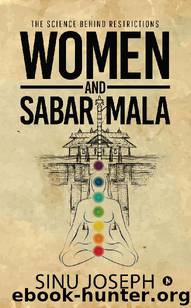Women and Sabarimala: The Science Behind Restrictions by Sinu Joseph

Author:Sinu Joseph [Joseph, Sinu]
Language: eng
Format: epub
Tags: Religion, Hinduism, General
ISBN: 9781647336349
Google: BDfBDwAAQBAJ
Publisher: Notion Press
Published: 2019-12-02T00:00:00+00:00
Image 1: Lord Sastha with Purnakala and Pushkala, at Sori Muthaiyan Kovil (Image Courtesy: V. Aravind Subramanyam)
Significance for Devotees
During festivals, lakhs of villagers throng to this temple. This temple is popular among villagers as a go-to place to get rid of evil possessions and to seek protection. The surroundings of this temple have various deities, with the most prominent being that of Pattavarayan, who is worshipped as a protector of the cattle. Then there is Brahma Rakshasi, who is prayed to, for fertility. There is also the Illupai tree, which is said to swallow the offering of a bell by devotees who pray for a child. We were shown bells of all sizes that the tree trunk had grown over, or in other words ‘swallowed’. The many deities, beliefs and associated legends, though fascinating, seem to distract from the shrine of Sastha and Swayambhu Linga. Looking back, it seems typical of what happens when a place is dominant in the muladhara chakra, where the play of Maya is very strong. People come here to overcome fear, insecurity, disease and to pray for fertility, health and wellbeing – all of which are functions of the muladhara chakra in the pravritti marg (action-oriented path).
The presence of Purnakala and Pushkala on either side of Sastha is also significant in understanding the nature of this place. Sometimes, they are referred to as Jnana (Knowledge) and Bhakti (Devotion). Often, devotees claim that they have Bhakti and hence, Jnana is not really essential and thereby dismiss the knowledge of chakras and shastras. Similarly, there are Jnanis who think that knowledge is sufficient and Bhakti is for the weaker mind. But the wise ones understand that real Jnana will nurture Bhakti and pure Bhakti will result in uncorrupt Jnana. In Sori Muthaiyan temple, we see that Jnana and Bhakti are separate from Sastha, indicating the gross (not-subtle) expressions of a person operating from muladhara. Whereas, as one goes higher up the chakras, we see that these two aspects are no longer separate entities and have become one with Sastha.
Those who consciously chose the nivritti marg (renunciation path) will begin to look beyond the outwardly possibilities and experience the pure chaitanyam in this place. That is why, for Ayyappa devotees who are supposed to be on the nivritti marg, this temple holds immense significance. It is the first place that will turn their attention inwards and help them rise beyond the insecurities of the material world, establishing them firmly on the path of mukthi marg.
It must be noted that my experience is probably just a tip of the iceberg, since I have not been initiated for this process. But unlike me, initiated Ayyappa devotees can surely experience this place much more powerfully. However, as we were told by the priest, only a small number of Ayyappa devotees come to this temple, and most don’t even know the significance of this place.
Muladhara Chakra significance
The Shat Chakra Nirupana has a large number of verses, from verse 4 to 13, dedicated to describing the muladhara chakra.
Download
This site does not store any files on its server. We only index and link to content provided by other sites. Please contact the content providers to delete copyright contents if any and email us, we'll remove relevant links or contents immediately.
Fingersmith by Sarah Waters(2409)
Kundalini by Gopi Krishna(2094)
Wheels of Life by Anodea Judith(1922)
The Bhagavad Gita by Bibek Debroy(1868)
Indian Mythology by Devdutt Pattanaik(1856)
The Yoga of Jesus: Understanding the Hidden Teachings of the Gospels by Paramahansa Yogananda(1755)
Autobiography of a Yogi (Complete Edition) by Yogananda Paramahansa(1741)
The Man from the Egg by Sudha Murty(1684)
Chakra Mantra Magick by Kadmon Baal(1589)
The Book of Secrets: 112 Meditations to Discover the Mystery Within by Osho(1589)
The Sparsholt Affair by Alan Hollinghurst(1509)
Avatar of Night by Tal Brooke(1451)
Sparks of Divinity by B. K. S. Iyengar(1450)
Karma-Yoga and Bhakti-Yoga by Swami Vivekananda(1437)
Gandhi by Ramachandra Guha(1437)
The Bhagavad Gita (Classics of Indian Spirituality) by Eknath Easwaran(1420)
The Spiritual Teaching of Ramana Maharshi by Ramana Maharshi(1373)
Hinduism: A Very Short Introduction (Very Short Introductions) by Knott Kim(1314)
Skanda Purana (Great Epics of India: Puranas Book 13) by Bibek Debroy & Dipavali Debroy(1309)
